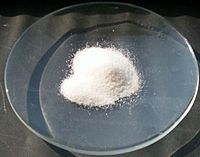Arsenik trioksid
Изглед
(преусмерено са Arsen trioksid)

| |

| |
| Identifikacija | |
|---|---|
3D model (Jmol)
|
|
| ChemSpider | |
| DrugBank | |
| ECHA InfoCard | 100.014.075 |
| |
| Svojstva | |
| As2O3 | |
| Molarna masa | 197,841 |
| Farmakologija | |
| Načini upotrebe | Oralno |
| Farmakokinetika: | |
| Renalno | |
Ukoliko nije drugačije napomenuto, podaci se odnose na standardno stanje materijala (na 25 °C [77 °F], 100 kPa). | |
| Reference infokutije | |
Arsenik trioksid je hemijsko jedinjenje, koje ima molekulsku masu od 197,841 Da.[3][4][5]
Osobine
[уреди | уреди извор]| Osobina | Vrednost |
|---|---|
| Broj akceptora vodonika | 3 |
| Broj donora vodonika | 0 |
| Broj rotacionih veza | 0 |
| Particioni koeficijent[6] (ALogP) | 0,0 |
| Rastvorljivost[7] (logS, log(mol/L)) | 2,6 |
| Polarna površina[8] (PSA, Å2) | 27,7 |
Reference
[уреди | уреди извор]- ^ Li Q, Cheng T, Wang Y, Bryant SH (2010). „PubChem as a public resource for drug discovery.”. Drug Discov Today. 15 (23-24): 1052—7. PMID 20970519. doi:10.1016/j.drudis.2010.10.003.
- ^ Evan E. Bolton; Yanli Wang; Paul A. Thiessen; Stephen H. Bryant (2008). „Chapter 12 PubChem: Integrated Platform of Small Molecules and Biological Activities”. Annual Reports in Computational Chemistry. 4: 217—241. doi:10.1016/S1574-1400(08)00012-1.
- ^ Lu, Jun; Chew, Eng-Hui; Holmgren, Arne (јул 2007). „Targeting thioredoxin reductase is a basis for cancer therapy by arsenic trioxide”. Proc Natl Acad Sci U S A. 104 (30): 12288—93. Bibcode:2007PNAS..10412288L. PMID 17640917. doi:10.1073/pnas.0701549104
 .
.
- ^ Knox, C.; Law, V.; Jewison, T.; Liu, P.; Ly, S.; Frolkis, A.; Pon, A.; Banco, K.; Mak, C.; Neveu, V.; Djoumbou, Y.; Eisner, R.; Guo, A. C.; Wishart, D. S. (2011). „DrugBank 3.0: A comprehensive resource for 'omics' research on drugs”. Nucleic Acids Research. 39 (Database issue): D1035—41. PMC 3013709
 . PMID 21059682. doi:10.1093/nar/gkq1126.
. PMID 21059682. doi:10.1093/nar/gkq1126.
- ^ Wishart, D. S.; Knox, C.; Guo, A. C.; Cheng, D.; Shrivastava, S.; Tzur, D.; Gautam, B.; Hassanali, M. (2008). „DrugBank: A knowledgebase for drugs, drug actions and drug targets”. Nucleic Acids Research. 36 (Database issue): D901—6. PMC 2238889
 . PMID 18048412. doi:10.1093/nar/gkm958.
. PMID 18048412. doi:10.1093/nar/gkm958.
- ^ Ghose, Arup K.; Viswanadhan, Vellarkad N.; Wendoloski, John J. (1998). „Prediction of Hydrophobic (Lipophilic) Properties of Small Organic Molecules Using Fragmental Methods: An Analysis of ALOGP and CLOGP Methods”. The Journal of Physical Chemistry A. 102 (21): 3762—3772. Bibcode:1998JPCA..102.3762G. doi:10.1021/jp980230o. Текст „noedit ” игнорисан (помоћ)
- ^ Tetko, I. V.; Tanchuk, V. Y.; Kasheva, T. N.; Villa, A. E. (2001). „Estimation of aqueous solubility of chemical compounds using E-state indices”. Journal of Chemical Information and Computer Sciences. 41 (6): 1488—1493. PMID 11749573. doi:10.1021/ci000392t.
- ^ Ertl, P.; Rohde, B.; Selzer, P. (2000). „Fast calculation of molecular polar surface area as a sum of fragment-based contributions and its application to the prediction of drug transport properties”. Journal of Medicinal Chemistry. 43 (20): 3714—3717. PMID 11020286. doi:10.1021/jm000942e.
Literatura
[уреди | уреди извор]- Holleman A. F.; Wiberg E. (2001). Inorganic Chemistry (1st изд.). San Diego: Academic Press. ISBN 0-12-352651-5.
- Housecroft, C. E.; Sharpe, A. G. (2008). Inorganic Chemistry (3. изд.). Prentice Hall. ISBN 978-0-13-175553-6.
Spoljašnje veze
[уреди | уреди извор]
 | Molimo Vas, obratite pažnju na važno upozorenje u vezi sa temama iz oblasti medicine (zdravlja). |
